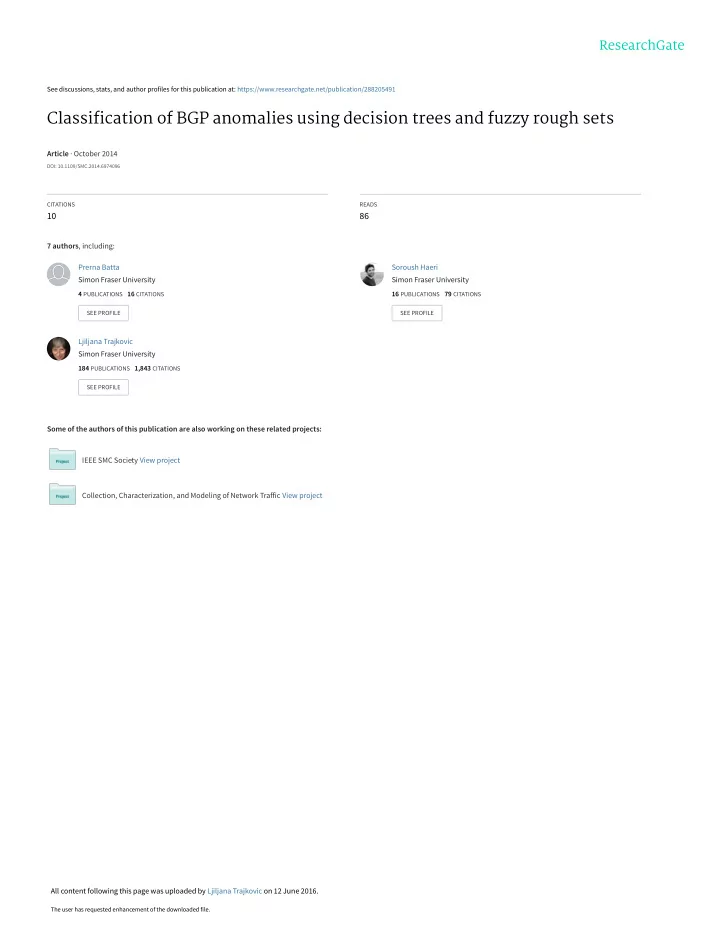

See discussions, stats, and author profiles for this publication at: https://www.researchgate.net/publication/288205491 Classification of BGP anomalies using decision trees and fuzzy rough sets Article · October 2014 DOI: 10.1109/SMC.2014.6974096 CITATIONS READS 10 86 7 authors , including: Prerna Batta Soroush Haeri Simon Fraser University Simon Fraser University 4 PUBLICATIONS 16 CITATIONS 16 PUBLICATIONS 79 CITATIONS SEE PROFILE SEE PROFILE Ljiljana Trajkovic Simon Fraser University 184 PUBLICATIONS 1,843 CITATIONS SEE PROFILE Some of the authors of this publication are also working on these related projects: IEEE SMC Society View project Collection, Characterization, and Modeling of Network Traffic View project All content following this page was uploaded by Ljiljana Trajkovic on 12 June 2016. The user has requested enhancement of the downloaded file.
Classification of BGP Anomalies Using Decision Trees and Fuzzy Rough Sets Yan Li, Hong-Jie Xing, Qiang Hua, and Xi-Zhao Wang Prerna Batta, Soroush Haeri, and Ljiljana Trajkovi´ c Hebei University Simon Fraser University Baoding, Hebei, China Vancouver, British Columbia, Canada Email: { ly, hjxing, huaq, wangxz } @hbu.cn Email: { pbatta, shaeri, ljilja } @sfu.ca feature space. Furthermore, feature extraction methods such as Abstract —Border Gateway Protocol (BGP) is the core compo- nent of the Internet’s routing infrastructure. Abnormal routing principal component analysis project the original data points behavior impairs global Internet connectivity and stability. Hence, onto a lower dimensional space. However, features transformed designing and implementing anomaly detection algorithms is by feature extraction lose their original physical meaning. important for improving performance of routing protocols. While various machine learning techniques may be employed to detect The main focus of approaches that have been proposed BGP anomalies, their performance strongly depends on the in the past is developing models for traffic classification. The employed learning algorithms. These techniques have multiple accuracy of a classifier depends on the extracted features, the variants that often work well for detecting a particular anomaly. combination of selected features, and the underlying model. In In this paper, we use the decision tree and fuzzy rough set methods this paper, we use feature selection methods to select subsets of for feature selection. Decision tree and extreme learning machine the original features while preserving the physical meaning of classification techniques are then used to maximize the accuracy the features. We examine the effects of feature selection on the of detecting BGP anomalies. The proposed techniques are tested performance of BGP anomaly classification. We employ two using Internet traffic traces. methods for feature selection (decision tree and fuzzy rough Keywords — Machine learning; decision tree; fuzzy rough sets; sets) and evaluate their performance in terms of classification extreme learning machine; weighted extreme learning machine. accuracy and execution time. We then train an extreme learning machine (ELM) [8], [9] classifier using the selected features. I. I NTRODUCTION ELM is a fast learning algorithm used with a single hidden layer feed-forward neural (SLFN) network. It randomly selects Border Gateway Protocol (BGP) enables exchange of the weights of the hidden layer and analytically determines routing information between gateway routers in a network the SLFN output weights. It avoids the iterative tuning of the of Autonomous Systems. Its main function is to exchange weights used in traditional neural networks and, hence, it is reachability information among BGP peers and select the best fast and could be used as an online algorithm. route based on a set of metrics such as the shortest AS- path, the nearest next-hop router, or routing policies. BGP This paper is organized as follows. In Section II, we anomalies are triggered by a variety of events such as session describe the BGP datasets and extracted features relevant to the resets, router misconfigurations, and link or router failures. detection of BGP anomalies. The proposed machine learning They affect Internet routers and, consequently, slow down techniques for feature selection and classification of anomalies servers and hosts. BGP anomalies often occur and techniques are described in Section III and Section IV, respectively. We for their detection have recently gained visible attention and conclude with Section V. importance. A number of anomaly detection techniques have been reported in the literature. II. U NDERSTANDING BGP D ATA Anomaly detection techniques have been applied in com- The datasets examined in this paper consist of BGP update puter networks [1]. These techniques are employed to detect messages collected by the R´ eseaux IP Europ´ eens (RIPE) under BGP anomalies that frequently affect the Internet [2], [3] and the Routing Information Service (RIS) project [10]. The RIPE its applications. They may be applied to detect BGP anomalies, and Route Views [11] BGP update messages are available to intrusion attacks, worms, and distributed denial of service at- the research community in the multi-threaded routing toolkit tacks (DDoS) because they all have similar characteristics [4], (MRT) binary format [12]. The Internet Engineering Task [5]. Anomaly detection may be viewed as a classification Force (IETF) introduced MRT to export routing protocol problem of assigning an “anomaly” or “regular” label to a messages, state changes, and content of the routing information data point. There are numerous machine learning methods that base (RIB). We filter the collected traffic for BGP update address these classification tasks. However, redundancies in messages during the time period when the Internet experienced the collected data may affect the performance of classification anomalies. In this paper, we consider three well-known worms: methods. Feature selection and feature extraction may be Slammer, Nimda, and Code Red I. Their details are listed in used to reduce redundancy among features and improve the Table I. generalization of classification algorithms. Feature selection methods such as decision tree [6] and fuzzy rough sets [7] The Structured Query Language (SQL) Slammer worm are used to select a subset of features from the original attacked Microsoft SQL servers on January 25, 2003 [13]. The
Recommend
More recommend